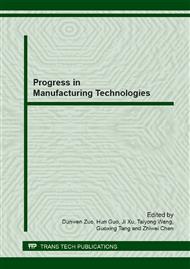p.9
p.15
p.21
p.27
p.33
p.39
p.45
p.53
p.59
Finite Element Analysis of Ultrasonic Vibration Assisted Turning of Ferrous Metals
Abstract:
Ultrasonic vibration assisted turning has significant improvements in processing of intractable materials compared to conventional turning. This paper presents a theoretical investigation of tool wear in single point diamond turning of ferrous metals based on numerical simulation. Finite element modeling and simulation of ultrasonic vibration turning process were performed, aimed at optimizing a series of technological parameters in the process of machining, reducing tool wear and improving surface quality as much as possible. The results revealed that the cutting speed and depth of cut are two crucial factors for tool wear, unlike the other parameters of vibration frequency, amplitude and flank angle. Moreover, this technological measure has observably decreased the cutting force and cutting temperature, so as to obtain superior surface finish.
Info:
Periodical:
Pages:
33-38
Citation:
Online since:
July 2013
Price:
Сopyright:
© 2013 Trans Tech Publications Ltd. All Rights Reserved
Share:
Citation:


